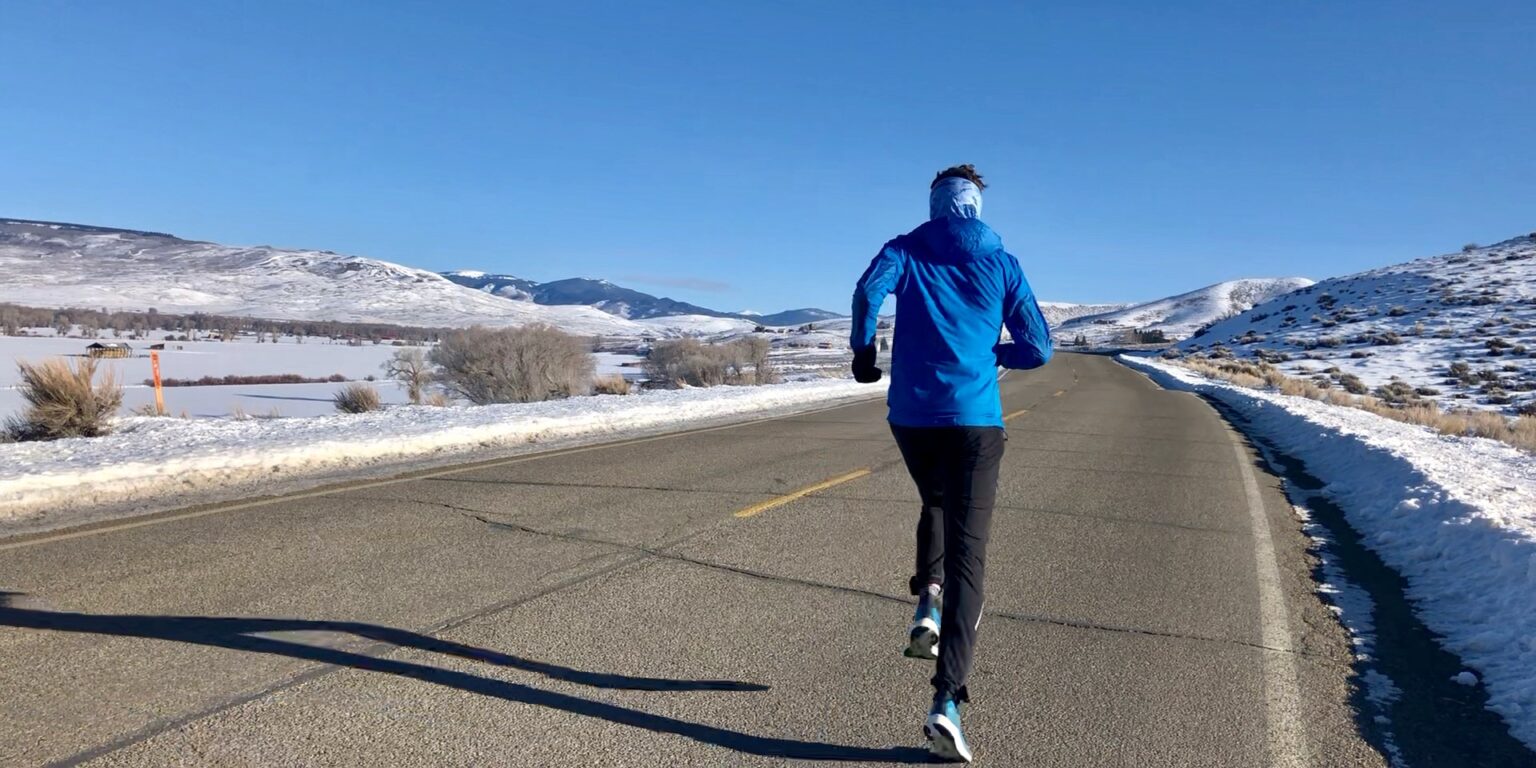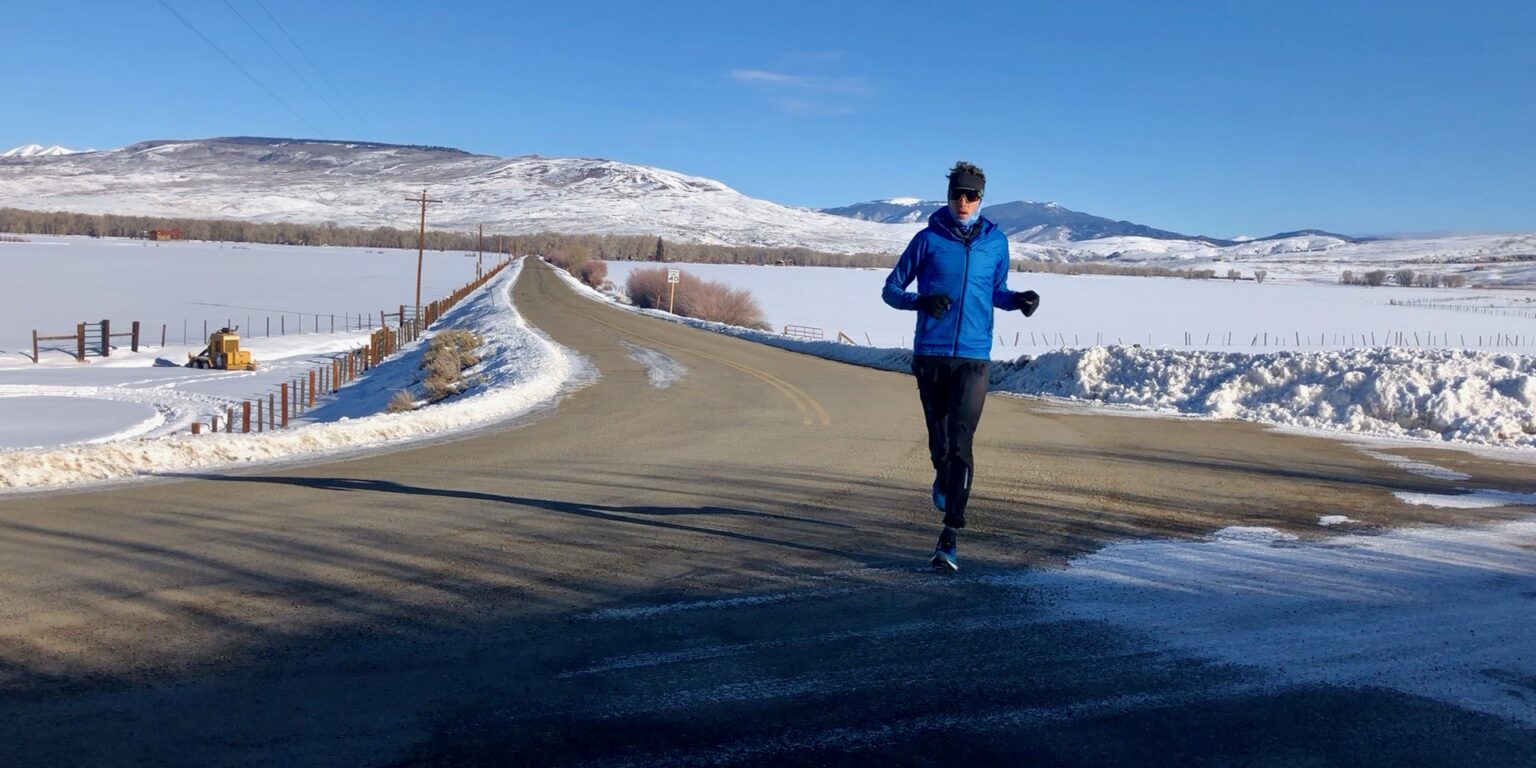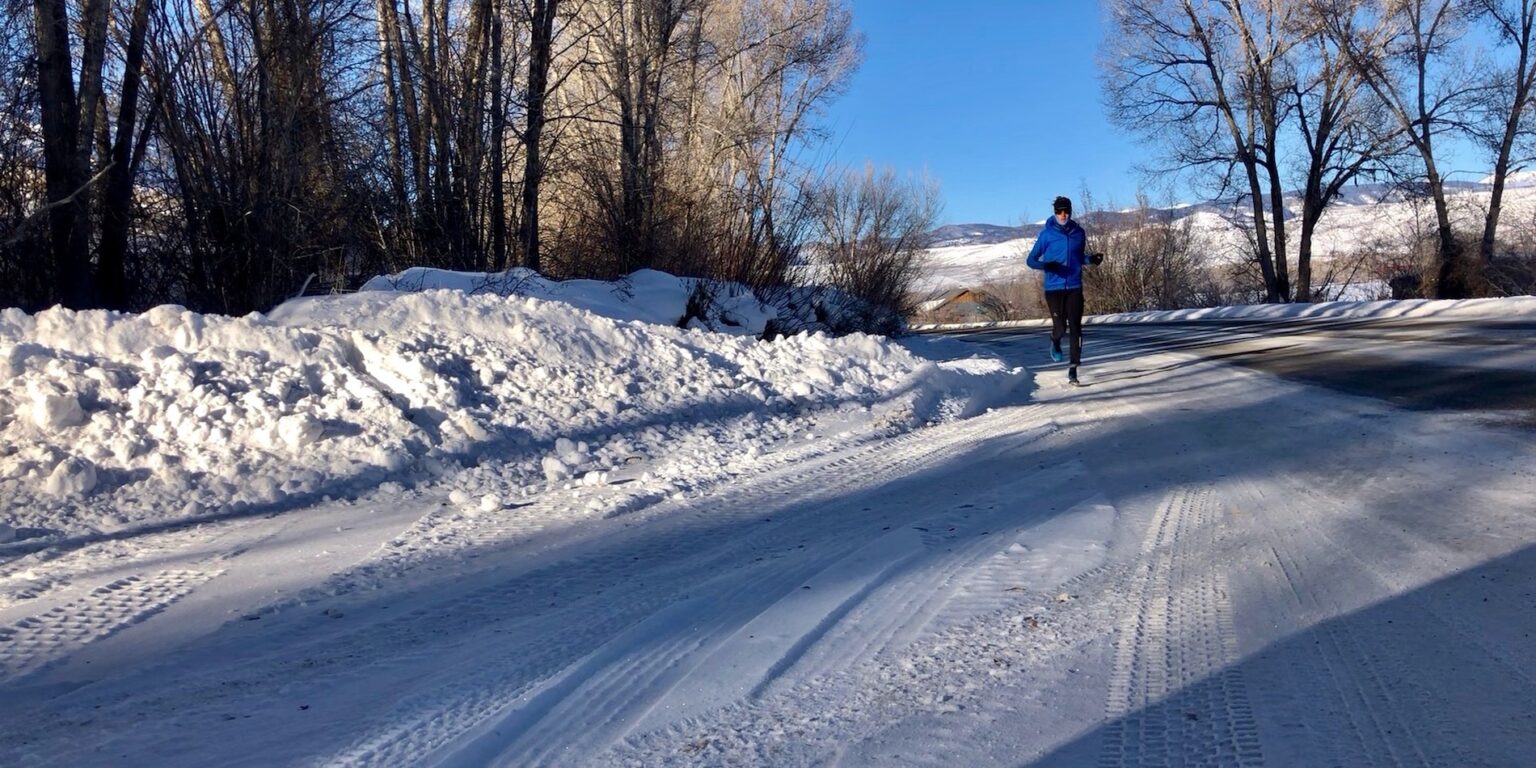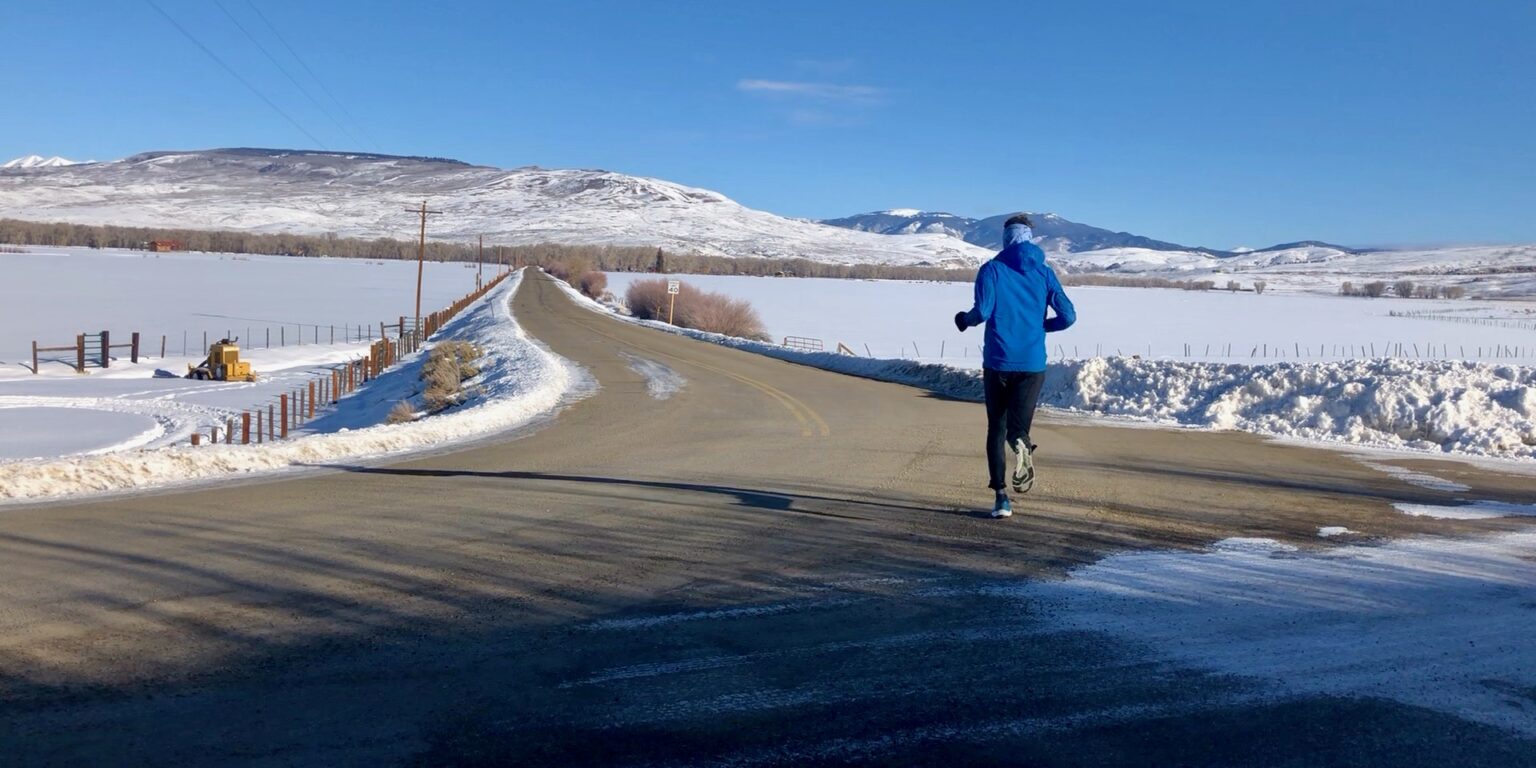Topo Athletic Zephyr
Test Locations: Gunnison — Crested Butte, Colorado
Test Duration: 65 miles
Stated Stack Height: 28 mm (heel) / 23 mm (forefoot)
Stated Heel-to-Toe Drop: 5 mm
Stated Features:
- Elastomer stability plate inside the midsole helps stabilize the forefoot and aid propulsion during plantar flexion
- 5mm drop allows you to access natural running with more under-heel cushioning
- ZipFoam Core offers more rebound and resilience than traditional EVA
- Lightweight, breathable mesh upper with printed overlays secures the foot
- Firm cushion, neutral support, stiff flex
Reviewer: 6’1″, 145 lbs / 185 cm, 66 kg
Size Tested: US Men’s 11.5
Stated Weight per Shoe (US Men’s Size 9): 266 g / 9.4 oz
Blister Measured Weight (US Men’s 11.5):
- Shoes + Laces: 280 g (left) & 277 g (right)
- Insoles: 24 g (left) & 26 g (right)
- Total: 304 g (left) & 303 g (right)
MSRP: $130
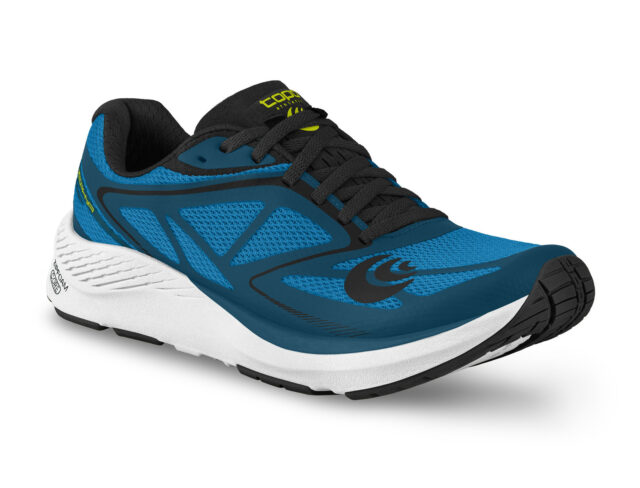
Intro
Running on trails during the winter in Gunnison usually ends up involving much more time spent post-holing than it does actually running — so I usually spend a whole lot more time running on the roads during the winter months than I do during the rest of the year. Last year, the Hoka One One Rincon was my go-to shoe for winter road running. But while I loved that shoe’s lightweight, cushioned ride, I did have some issues with blisters / hot spots on longer runs in the shoe, mostly because of its fairly narrow toe box.
With that in mind, I’ve been very curious about Topo Athletic’s road shoes — they have much wider toe boxes than the majority of Hoka’s offerings, but seem fairly similar otherwise on paper (similar stack heights, drops, etc.). The Zephyr caught my eye because it has many of the same features that I loved about the Hoka Rincon — a high stack height, fairly firm cushioning, and a reasonably light stated weight.
Topo markets the Zephyr as a “Tempo Running” shoe, which I take to mean that it’s designed for faster running in workouts and races. To that end, the Zephyr has a plastic plate in the midsole that supposedly provides the same benefits as the carbon plates in shoes like the Hoka One One Carbon X — namely, better energy return and efficiency. I thought that the Hoka Rincon felt pretty darn efficient without any sort of plate, so I was curious to see whether or not the Zephyr’s design could actually improve the shoe’s efficiency out on the roads.
Fit
As always, it’s a good idea to try on the Zephyr in person if you’re able to. With that said, I’ll provide a general overview of how it fits my feet. For reference, I have fairly narrow, low volume feet with low arches. I usually prefer shoes with a secure fit through the midfoot and heel, but that still offer plenty of space for toe-splay.
Like other Topo shoes I’ve reviewed, I was pretty happy with the Zephyr’s fit — and particularly with its toe box. The Zephyr has a wide, rounded toe box that feels similarly spacious to the toe box of shoes like the Altra Torin. As I had hoped, the Zephyr’s wide toe box completely eliminated the blister / hot spot issues I’ve had in shoes with narrower toe boxes (namely, the Hoka Rincon).
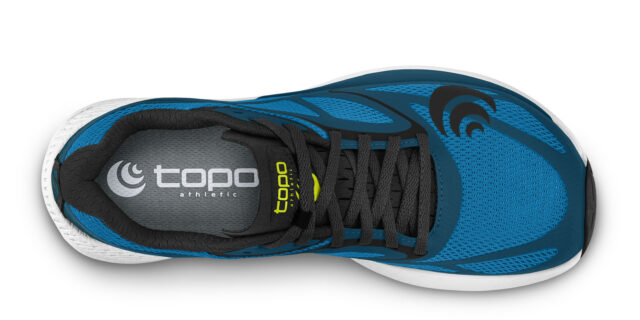
The Zephyr’s midfoot and heel also fit very well in my opinion. The midfoot feels secure without being overly tight, and the heel cup provides a comfortable amount of cushion without feeling sloppy. It can be a little difficult to initially get my foot into the shoe because of its fairly rigid tongue (more on that later), but once it’s on, the Zephyr feels secure and comfortable.
If you’ve run in and enjoyed Altra’s road shoes, I’d imagine the Zephyr’s fit will probably feel pretty good. It could also be a good option if you’ve been running in road shoes from Hoka or Salomon and want something with a little more toe box space, but that isn’t a zero-drop shoe.
Weight
The Zephyr is a little on the heavy side for a road shoe that’s designed for running fast. I think a lot of that weight probably comes from the elastomer plate in the midsole — so there are some tradeoffs between the shoe’s fast feel (more on that later) and its weight. Still, there numerous other shoes on the market that have much lighter stated weights, many of which use similar midsole plate technologies and offer just as much (if not even more) cushioning (all stated weights are based on a US Men’s Size 9):
187 g / 6.6 oz — ASICS MetaRacer
187 g / 6.6 oz — Nike Zoom Vaporfly Next %
213 g / 7.5 oz — Brooks Hyperion Elite 2
225 g / 7.9 oz — ON Running Cloudboom
249 g / 8.8 oz — Hoka One Carbon X
258 g / 9.1 oz — Altra Torin 4
266 g / 9.4 oz — Topo Athletic Zephyr
In all fairness, most of these shoes (actually, all of them except for the Altra Torin) have two pretty significant differences from the Zephyr. First, they have carbon-fiber plates rather than more general “plastic” ones, which are going to save a bit of weight. And secondly, they are way more expensive (MSRPs of $200-$250 vs. the Zephyr’s MSRP of $130) — partially because of those carbon-fiber plates. Still, while comparing the Zephyr to a shoe like the Nike Zoom Vaporfly Next % might not be a totally fair comparison, it does illustrate the fact that the Zephyr is definitely not the lightest road shoe available that’s designed for workouts and races — it’s not even close.
In practice, the Zephyr does feel a little heavy compared to other road shoes I’ve run in, but its extra weight doesn’t necessarily make it feel particularly slow or cumbersome. Below I’ll go into more detail, but I do think the Zephyr’s elastomer plate gives it a fast, efficient ride, even though it isn’t the lightest road shoe around. I’m sure that shoes like the Zoom Vaporfly Next % would feel significantly lighter, faster, and more efficient, but I don’t think that the Zephyr’s extra weight necessarily prevents it from being a good shoe for certain uses.
Upper
The Zephyr’s upper has a simple and effective design. It basically consists of a fairly thin, open mesh with synthetic overlays connecting the lacing system to the midsole and providing some extra support / structure in high-wear areas. The mesh used in the Zephyr’s upper isn’t particularly soft or stretchy, but it has provided a comfortable fit. I haven’t had any issues with blisters or hot spots in the Zephyr, even on runs up to 2 hours long. I haven’t had the chance to test the Zephyr in any hot weather yet, but it seems like the upper is breathable enough that the same would hold true in warmer conditions.

Midsole
The Zephyr’s midsole has three main components: an EVA foam “frame,” the elastomer plate, and an interior insert of Topo’s TPU-based ZipFoam material. The EVA frame is pretty standard — it’s the part of the midsole that you actually see when looking at the shoe, and it uses a traditional, fairly firm EVA foam. The elastomer plate sits inside this “frame,” supposedly providing extra support / stability through the forefoot and improving energy return. Lastly, the ZipFoam insert sits on top of the plate, directly under your foot. Topo’s ZipFoam is allegedly a bit softer and springier than the traditional EVA used for the rest of the midsole.
I’m usually a little skeptical of complex, multi-piece midsoles — they rarely seem to accomplish much, aside from just giving brands an excuse to come up with more fancy-sounding names for what’s essentially just some pieces of foam. But I think the Zephyr’s midsole design actually fulfills its intended purpose pretty darn well.
The combination of the firm EVA frame and fairly rigid elastomer plate make the Zephyr a very firm, inflexible shoe — which kind of threw me off at first. For a shoe with a 28 mm (heel) / 23 mm (toe) stack height, the Zephyr doesn’t feel very cushioned or plush. At slower paces, this can make the shoe feel a little jarring when compared to shoes with softer midsoles like the Altra Torin or Hoka Clifton.
Outsole
Like the upper, the Zephyr’s outsole is straightforward and effective. Like most road shoes, it consists of a mix of rubber pods in high-wear areas of the forefoot and heel, with exposed EVA midsole foam through the midfoot to save weight. There’s also a cutout in the middle of the outsole that exposes the elastomer plate above the lowermost layer of midsole foam.

On The Road
The Zephyr is marketed as a “tempo running” shoe, and I think Topo is pretty much spot-on with that description. Aside from the Zephyr, I’ve done most of my road running in the Altra Torin 3.5 and various iterations of the Hoka One One Rincon. The Zephyr feels much more efficient than either of these shoes at faster paces for two reasons. First, as I mentioned earlier, the combination of the Zephyr’s firm EVA midsole and elastomer plate provide better energy return than the single-piece EVA midsoles of the Torin and Rincon.
Second, the Zephyr has a fairly aggressively rockered midsole geometry through the forefoot. When viewed from the side, the front of the shoe curves upwards starting under the ball of the foot. Much like the Topo Mtn Racer this makes the Zephyr feel like it has a much lower heel-to-toe drop than it actually does. And as with the Mtn Racer, I like that design because I’m already a forefoot striker — and when paired with the shoe’s excellent energy return, this geometry gives the Zephyr an even more efficient feel. With that said, the Zephyr’s rockered midsole and 5 mm heel-to-toe drop could feel a little awkward if you’re more of a heel-striker.
Because of the Zephyr’s efficient ride, it has become my go-to shoe for interval workouts on the roads. If I was a serious road racer and wanted a race-day shoe, I’d probably be tempted to look for something a little lighter — but the Zephyr is light enough and provides enough energy return that it feels plenty efficient for interval sessions. Interestingly, I’ve found that the Zephyr actually feels more efficient than the Hoka One One Rincon 2 at faster paces — even though the Rincon 2 is supposedly 1.6 oz / 45 g lighter per shoe.
With all of that said, the Zephyr wouldn’t be my top choice for a longer, slower road run. For those days, I still prefer a slightly softer, more forgiving shoe like the Rincon 2. While the Zephyr’s firm, propulsive cushioning feels great for up-tempo runs, it does leave my legs — and especially my shins and calves — feeling a little more beat up after runs longer than 1.5-2 hours. Then again, the Zephyr is supposed to be a fast shoe for workouts and races, so I wouldn’t necessarily expect it to shine on slower, longer runs.
Durability
I’ve read a few online user reviews complaining about durability issues with the Zephyr, but my pair seems to be holding up just fine after about 65 miles of use. Of course, I’ll have to put many more miles on the shoe before I can comment on its long-term durability, but up to this point, the Zephyr looks pretty much the same as it did when it came out of the box. The upper doesn’t show any signs of wear or fraying, the cushioning feels just as resilient as it did on my first run in the shoe, and the outsole isn’t showing any significant wear. If (or rather, when) any of that changes down the road, I’ll update this section with the details.
Who’s It For?
As advertised, I think the Zephyr is a solid option for runners looking for a shoe for faster training days and, depending on your preferences, races. There are certainly lighter, likely even more energetic shoes on the market (the Hoka One One Rocket X or Nike Zoom Vaporfly Next % come to mind) — but many of those shoes often come with a $200 + price tag. The Zephyr is fairly comparable to most other “normal” road shoes price-wise, so it’s much easier to justify using it as a training / workout shoe, rather than reserving it exclusively for races.
Like most Topo shoes, I think the Zephyr could also be a potential solution for runners who run into issues with shoes from brands like Hoka or Altra. Like all of Altra’s shoes, the Zephyr has a wide toe box — so it should provide a bit more room for runners with wide feet than shoes from a brand like Hoka or Salomon might. Conversely, the Zephyr has a 5 mm drop — so if Altra’s zero-drop platform doesn’t work for you but you still want a shoe with a wide toe box, the Zephyr could be a good option.
Bottom Line
I’ve been very happy to have the Topo Athletic Zephyr as an option for interval days so far this winter. Its fast, energetic ride and wide toe box make it both more comfortable and efficient than my usual road kicks (the Hoka One One Rincon) — at least for faster-paced runs and workouts. I still prefer the softer, more forgiving Rincon for longer, slower efforts, but the Zephyr has quickly become my go-to shoe for faster days. I’d be even more excited about the Zephyr if it was an ounce or two lighter, but as it stands, it’s still light enough to avoid feeling cumbersome on the road. I’m always impressed when a shoe actually lives up to its stated purpose, and so far it seems like the Zephyr does just that. If you’re looking for a fast, efficient shoe for up-tempo workouts on roads, I think the Zephyr should definitely be on your list.

